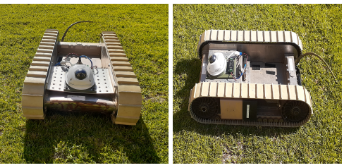2023-10-12 オーストラリア連邦・南オーストラリア大学(UniSA)

- UniSA とチャールズ・スタート大学が、無人の軍用ロボットへの中間者(MitM)サイバー攻撃を停止させるアルゴリズムを開発。
- 米国陸軍フューチャーコマンド(AFC)と共同で GVR-BOT 地上車両への MitM サイバー攻撃を再現。深層学習(DL)ニューラルネットワーク(NN)を用いてロボットオペレーティングシステム(ROS)を訓練し、MitM 盗聴サイバー攻撃のシグネチャを学習させた。高度にネットワーク化された ROS は、データ漏洩やハイジャック攻撃を受けやすい。
- 米国陸軍の地上車両のレプリカによる新アルゴリズムのリアルタイム試験では、悪意のある攻撃を99%回避できた。2%を下回る偽陽性率により、同システムの効果を実証。現在世界で使用されている他のサイバー攻撃検出方法を超える性能を提供する。
- ロボティクス、オートメーションや IoT を革新するインダストリー4.0 の登場により、センサー、アクチュエーターやコントローラー間でのクラウドサービスを介した通信や情報交換が必須のロボットとの協働が必要となっているが、その弱点はサイバー攻撃への脆弱性。
- 演算速度は数年毎に倍増しており、現在はデジタル攻撃からシステムを保護する高度な AI アルゴリズムの開発と実行が可能となっている。ROS の数々の利点や広範囲にわたる利用にも関わらず、その暗号化されたネットワークトラフィックデータと限られた整合性確認能力のため、コーディングスキームでのセキュリティーの問題が見落とされることが多い。
- DL を利用したこの新しい侵入検出フレームワークは強力・高精度で、ROS のような大規模でリアルタイムのデータ駆動システムの保護に最適となる大規模なデータセットを処理できる。地上ロボットよりも高速で複雑なダイナミクスをもつドローンを含む、様々な種類のロボティックプラットフォームでこのアルゴリズムの試験を実施する予定。
- 2023 年に 370 億ドルに達するとされるロボティクス市場では、サービスロボットがその大部分を占め、軍用、民間用、農業用、産業用、捜索救助や医療分野等の他のロボットの使用が世界で増加している。
- 本研究は、AFC、米国陸軍戦闘能力開発コマンド(DEVCOM) 地上車両システムセンター (GVSC) および米国陸軍国際技術センター太平洋支部 (ITC-PAC)が支援した。
- URL: https://www.unisa.edu.au/media-centre/Releases/2023/new-cyber-algorithm-shuts-down-malicious-robotic-attack/
<NEDO海外技術情報より>
関連情報
IEEE Transactions on Dependable and Secure Computing 掲載論文(フルテキスト)
Trusted Operations of a Military Ground Robot in the Face of Man-in-the-Middle Cyber-Attacks Using
Deep Learning Convolutional Neural Networks: Real-Time Experimental Outcomes
URL: https://ieeexplore.ieee.org/stamp/stamp.jsp?tp=&arnumber=10210500
Abstract
Safe and secure operations of robotic systems are of paramount importance. Aiming for achieving the trusted operation of a military robotic vehicle under contested environments, we introduce a new cyber-physical system based on the concepts of deep learning convolutional neural networks (CNNs). The proposed algorithm is specifically designed to reduce the cyber vulnerability of the Robot Operating System (ROS), a well-known middleware platform widely used in both civilian and military robots. To demonstrate the efficacy of the proposed algorithm, we conduct penetration testing (real-time man-in-the-middle cyber attack) on the GVR-BOT ground vehicle, a military ground robot, developed by the United States Army Combat Capabilities Development Command (CCDC), Ground Vehicle Systems Center. The cyber attack also exploits the vulnerability of the Robot Operating System (ROS) employed in its onboard computer. We collect experimental data and train our CNN based on two different operating conditions, namely, legitimate and malicious conditions. We normalize and convert the network traffic data in the form of RGB or grayscale images. We introduce two different types of windowing techniques, namely, the independent and overlapping sliding epochs to efficiently feed the network traffic data to our CNN system. Our research indicates the efficacy of the proposed algorithm as our proposed cyber intrusion detection system can achieve reasonably high accuracy of $\geq 99$ % and substantially small false-positive rates $\leq$ 2 % supported with minimum detection time. In addition, we also compare and demonstrate the relative merits of our proposed algorithm with respect to the performance of some well-known techniques, namely, ‘bag-of-features’ and Support Vector Machine (SVM) algorithms.



